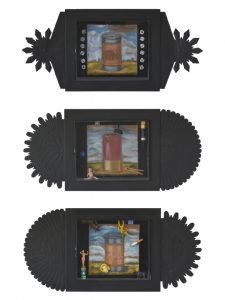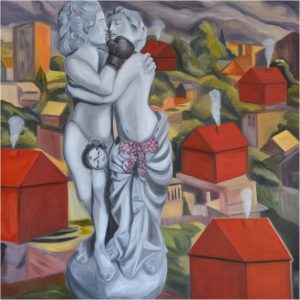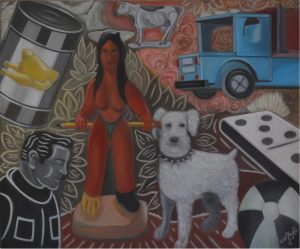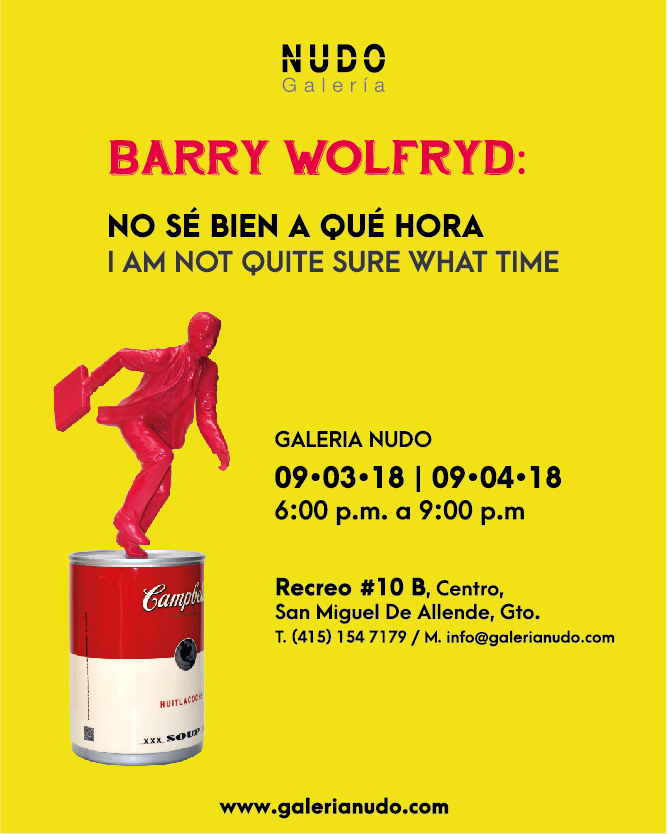English text below
«Si nadie te garantiza el mañana, el hoy se vuelve inmenso»
Carlos Monsiváis
No sé bien en dónd e trazar las fronteras entre el arte pop, el kitsch y el naif en la obra de Barry Wolfryd. Y es que su arte creció y se desarrolló primero en su natal Los Ángeles, ciudad que poco a poco fue volviéndose otra vez parte de México, pues la cantidad de mexicanos que ahí viven han configurado su perfil a tal grado, que es la segunda metrópoli del mundo con más mexicanos después de nuestra monstruosa capital. Eso ya era suficiente para que el arte de Barry fuera híbrido. Pero él se vino a vivir a México, justo cuando nuestra propia cultura se ha visto más invadida y transfigurada por la cultura mediática norteamericana, así que parece que su vida y su arte son un juego de reflejos marcados por la cultura popular de ambos lados, como se hace evidente en esos nichos tan típicos de México en los que en lugar de un santo o una virgen venerados por el pueblo se ha pintado una sagrada lata de beans, no de frijoles.
e trazar las fronteras entre el arte pop, el kitsch y el naif en la obra de Barry Wolfryd. Y es que su arte creció y se desarrolló primero en su natal Los Ángeles, ciudad que poco a poco fue volviéndose otra vez parte de México, pues la cantidad de mexicanos que ahí viven han configurado su perfil a tal grado, que es la segunda metrópoli del mundo con más mexicanos después de nuestra monstruosa capital. Eso ya era suficiente para que el arte de Barry fuera híbrido. Pero él se vino a vivir a México, justo cuando nuestra propia cultura se ha visto más invadida y transfigurada por la cultura mediática norteamericana, así que parece que su vida y su arte son un juego de reflejos marcados por la cultura popular de ambos lados, como se hace evidente en esos nichos tan típicos de México en los que en lugar de un santo o una virgen venerados por el pueblo se ha pintado una sagrada lata de beans, no de frijoles.
Así es, México ha transfigurado la dieta norteamericana con su gastronomía, pero Estados Unidos nos la devuelve enlatada, i ndustrializada o en fast food, y nosotros la consumimos alegremente. Las obras de este artista muestran estas idas y vueltas, estos intercambios y metamorfosis de la realidad a través de las imágenes y del humor: si hay un pintor irónico en la escena nacional o binacional, ese es el buen Barry. No hay aquí espacio para explicar cada obra de esta exposición, pero el hombre que corre con un portafolios en mano sobre un cilindro estampado con imágenes icónicas del narcotráfico, parece representar esta nueva cultura de las apuestas, time is money, violencia como sistema y vidas cortas pero llenas de fortunas artificiales, un estilo de vida que casualmente se instaló y nos llegó enlatado junto con el Tratado de Libre Comercio.
ndustrializada o en fast food, y nosotros la consumimos alegremente. Las obras de este artista muestran estas idas y vueltas, estos intercambios y metamorfosis de la realidad a través de las imágenes y del humor: si hay un pintor irónico en la escena nacional o binacional, ese es el buen Barry. No hay aquí espacio para explicar cada obra de esta exposición, pero el hombre que corre con un portafolios en mano sobre un cilindro estampado con imágenes icónicas del narcotráfico, parece representar esta nueva cultura de las apuestas, time is money, violencia como sistema y vidas cortas pero llenas de fortunas artificiales, un estilo de vida que casualmente se instaló y nos llegó enlatado junto con el Tratado de Libre Comercio.
¿O no nos hemos dado cuenta de la coincidente línea de crecimiento del Tratado de Libre Comercio con el crimen organizado, como señala ahora el locuaz Trump, con cierta verdad mañosa en su bocota, pero callándose el hecho de que México también se infestó de armas y violencia que nos llegaron del otro lado? Pero la obra de Barry ni juzga, ni sermonea, lo que él hace es registrar los híbridos visuales, los discursos que resumen las imágenes, y reconfigurarlos en un arte que parece una suma de tiempos y culturas, pero que en realidad es esta licuadora cultural del hoy, este túnel simultáneo donde pasa todo al mismo tiempo y descubrimos que el futuro era retro y la vida es tener vecinos armados hasta los dientes que se disfrazan de buenos y nobles ciudadanos.
No sé bien a qué hora Barry se volvió mexicano, pero su pintura, sus cerámicas, sus objetos, nos proyectan con mucha más claridad de lo que nosotros nos entendemos, y cuando digo nosotros, hablo de lo que nos está pasando en ambos lados de la frontera.
Fernando Gálvez de Aguinaga
I’m not quite sure what time
«If nobody guarantees tomorrow, today becomes immense.»
Carlos Monsiváis
I really don’t know how to plot the limits between pop art and the naif in the work of Barry Wolfryd. His art grew first in his native Los Angeles, a city that slowly has become almost a part of Mexico since it holds more Mexicans than any other city after our own monstrous capital. This alone was enough to make Wolfryd’s art a hybrid. But he came to live in Mexico, just when our own culture appeared to be invaded and transfigured by the media culture of North America. So it seems that his life and art are a play of reflections marked by the popular culture on both sides of the border. This is evident in those niches, so typical in Mexico, where instead of the saint or virgin worshiped by the people, he has painted a sacred can of beans, i.e., not frijoles. It’s true that Mexico has tra nsformed the North American diet with its gastronomy but the United States has returned it canned or as fast food and we happily eat it. The work of this artist shows these ups and downs, these trade-offs and transformations of reality, through images and humor: if there ever was an ironic painter on the national or binational scene, that painter is indeed Barry. There is not enough space here to explain each work, but, for example, the man running with his briefcase in hand on a cylinder printed with iconic images of the drug trade seems to show this new culture of investment gambles, time is money, violence as a system and short-but-full-of-easy-money lives: that which coincidentally established itself and came to us canned along with the NAFTA. Or maybe we haven’t realised the coincidence of the growth of the NAFTA with that of organised crime, as the loquacious Trump is fond of pointing out with a certain shrewd truth, although he is mainly silent about the fact that Mexico became infested with the weapons and violence that came to us from the other side of the border. But Wolfryd’s work does not judge or preach. What he does is to record the visual hybrids as discourses that boil down the images and reconfigure them into an art that sums up the times and the culture that really is today’s cultural blender, this simultaneous tunnel where everything passes at once and we discover that the future was retro and life means having neighbours armed to the teeth who masquerade as good and noble citizens. I really don’t know when Barry Wolfryd became Mexican, but his painting, his ceramics and his objects project with much more clarity our understanding—and by “our” I refer to that which is happening on both sides of the border.
nsformed the North American diet with its gastronomy but the United States has returned it canned or as fast food and we happily eat it. The work of this artist shows these ups and downs, these trade-offs and transformations of reality, through images and humor: if there ever was an ironic painter on the national or binational scene, that painter is indeed Barry. There is not enough space here to explain each work, but, for example, the man running with his briefcase in hand on a cylinder printed with iconic images of the drug trade seems to show this new culture of investment gambles, time is money, violence as a system and short-but-full-of-easy-money lives: that which coincidentally established itself and came to us canned along with the NAFTA. Or maybe we haven’t realised the coincidence of the growth of the NAFTA with that of organised crime, as the loquacious Trump is fond of pointing out with a certain shrewd truth, although he is mainly silent about the fact that Mexico became infested with the weapons and violence that came to us from the other side of the border. But Wolfryd’s work does not judge or preach. What he does is to record the visual hybrids as discourses that boil down the images and reconfigure them into an art that sums up the times and the culture that really is today’s cultural blender, this simultaneous tunnel where everything passes at once and we discover that the future was retro and life means having neighbours armed to the teeth who masquerade as good and noble citizens. I really don’t know when Barry Wolfryd became Mexican, but his painting, his ceramics and his objects project with much more clarity our understanding—and by “our” I refer to that which is happening on both sides of the border.
Fernando Gálvez de Aguinaga



